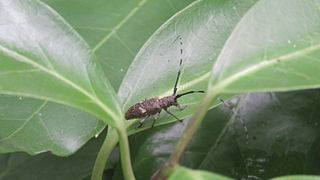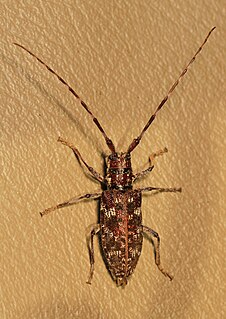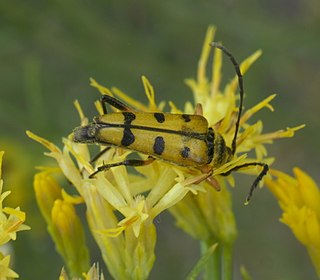
Paul Lake Provincial Park is a provincial park in British Columbia, Canada, located southwest of Heffley Lake and to the northeast of the city of Kamloops.

Richardsonius is a genus of cyprinid fish consisting of two species native to western North America. Commonly known as redside shiners, that term is also used to refer to Richardsonius balteatus specifically. The genus is named after naturalist Sir John Richardson (1787–1865), who described R. balteatus in 1836.

Monochamus is a genus of longhorn beetles found throughout the world. They are commonly known as sawyer beetles or sawyers, as their larvae bore into dead or dying trees, especially conifers such as pines. They are the type genus of the Monochamini, a tribe in the huge long-horned beetle subfamily Lamiinae, but typically included in the Lamiini today.

Episyrphus balteatus, sometimes called the marmalade hoverfly, is a relatively small hoverfly (9–12 mm) of the Syrphidae family, widespread throughout the Palaearctic region, which covers Europe, North Asia, and North Africa. The upper side of the abdomen is patterned with orange and black bands. Two further identification characters are the presence of secondary black bands on the third and fourth dorsal plates and faint greyish longitudinal stripes on the thorax. Its color patterns may appear wasp-like to other animals, such as birds, protecting it from predation.

Bombus balteatus, the golden-belted bumble bee, is a species of bumblebee with a boreal and high altitude distribution in northern Eurasia and North America.

Conus balteatus, common name the Mauritian cone, is a species of sea snail, a marine gastropod mollusk in the family Conidae, the cone snails and their allies.

The redside shiner is a species of cyprinid fish found in the western United States and Canada.

Monochamus scutellatus, commonly known as the white-spotted sawyer or spruce sawyer or spruce bug, is a common wood-boring beetle found throughout North America. It is a species native to North America.

Furcifer balteatus, also known as the two-banded chameleon or the rainforest chameleon, is a species of chameleon that is endemic to Madagascar. It was described by André Marie Constant Duméril and Gabriel Bibron in 1851.
Heteroconger balteatus is an eel in the family Congridae. It was described by Peter Henry John Castle and John Ernest Randall in 1999. It is a marine, tropical eel which is known from Saudi Arabia and the Red Sea, in the western Indian Ocean. It is known to dwell at a minimum depth of 46 m (151 ft), and inhabits regions of current, where it forms burrows in sand. It enters its burrows tail-first. Females can reach a maximum total length of 33.1 cm.
The Rhinohorn goby, Girdled goby or Skunk goby is a species of goby native to the Sri Lanka, Philippines, Malaysia, Indonesia, Japan, New guinea, Madagascar, and Mozambique. This species inhabits coastal estuaries, lakes and freshwater streams. It can reach a length of 3.8 centimetres (1.5 in) SL.

Monochamus subfasciatus is a species of beetle in the family Cerambycidae. It was described by Henry Walter Bates in 1873. It is recorded from Japan where it infests Japanese red pine and is a vector of the nematode Bursaphelenchus doui.
Monochamus adamitus is a species of beetle in the family Cerambycidae. It was described by James Thomson in 1857. It is known from Tanzania, Sierra Leone, Angola, Ghana, Mozambique, the Ivory Coast, Senegal, the Democratic Republic of the Congo, Malawi, and Zimbabwe.

Monochamus sutor is a species of beetle in the family Cerambycidae. It was described by Carl Linnaeus in 1758, originally under the genus Cerambyx. It has a wide, natural distribution throughout Europe, and has also been introduced into Belgium and the Netherlands. Adults measure between 15 to 24 mm, and larvae measure up to 45 mm (1.8 in).

The spotted pine sawyer is a species of beetle in the family Cerambycidae. It was described by John Lawrence LeConte in 1852.

Monochamus galloprovincialis, the pine sawyer beetle, also referred to as the black pine sawyer beetle, is a species of beetle in the family Cerambycidae. It was described by Olivier in 1795, originally under the genus Cerambyx. It has a wide distribution, occurring naturally throughout Europe and the Caucasus. It has also been introduced into the Canary Islands. It serves as a vector for the parasitic nematode species Bursaphelenchus xylophilus, and also acts as a host to the parasitoid wasp species Dolichomitus tuberculatus.
Monochamus leuconotus is a species of beetle in the family Cerambycidae. It was described by Francis Polkinghorne Pascoe in 1869, originally under the genus Anthores. It is known from Tanzania, Cameroon, Malawi, Kenya, Mozambique, Namibia, South Africa, Uganda, the Democratic Republic of the Congo, Zambia, Angola, and Zimbabwe. It feeds on Coffea arabica.
Monochamus ruspator is a species of beetle in the family Cerambycidae. It was described by Johan Christian Fabricius in 1781, originally under the genus Lamia. It has a wide distribution throughout Africa.

Monochamus sartor is a species of beetle in the family Cerambycidae. It was described by Johan Christian Fabricius in 1787, originally under the genus Lamia. It is known from throughout Europe, as well as in Kazakhstan, Mongolia, North Korea and South Korea. It is rated by the IUCN as Least Concern.

Typocerus balteatus is a species of flower longhorn in the beetle family Cerambycidae. It is found in North America.














